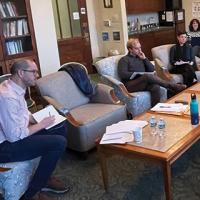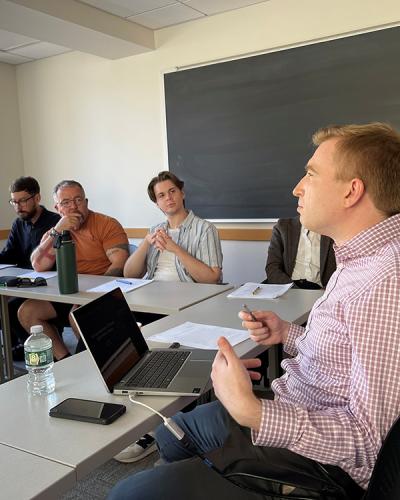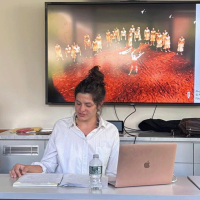On Friday March 9th, 2018, Professor Paul Fleming (Cornell) kicked off the conference The Aesthetics & Theology of the St. Matthew Passion: Bach and Blumenberg with an invigorating talk entitled “Messianic Minimalism: Anecdotes of the Coming World (Benjamin, Bloch, Blumenberg).” The talk set the stage for a full day of dialogue around German philosopher Hans Blumenberg’s monumental study Matthäuspassion (currently being translated into English by Fleming and his collaborator Helmut Müller-Sievers). Fleming began by addressing the book’s peculiarities. Though putatively about Bach’s St. Matthew Passion, Blumenberg’s Matthäuspassion tends more to circle around Bach’s work than directly engage with it, taking as its object not the particularity of Bach’s music, libretto, or even intellectual-historical context (a “triple-neglect” for Fleming), but rather, the relationship of the listener as a figure of analysis to the Protestant artwork as such. In addressing this question Blumenberg pursues a distinct style: essaystic, musing, anecdotal, lacking any common thread or systematic argument. For Fleming, this choice of style is purposeful and programmatic, reminiscent of the late Adorno. Fleming argued that due to Blumenberg’s formal strategy, the book does not seek the historical meaning of or truth behind Bach’s oratorio, just as the oratorio does not represent the truth or historical meaning of the gospel. Instead, for Blumenberg, the oratorio addresses itself to a new listener and helps to create this new listener who is perforce a new Christian hearing a new gospel for himself, in true Lutheran fashion. Likewise Blumenberg’s book seeks a form of writing that performs for a new readership as the oratorio must perform for a new listenership. In Fleming’s argument, Blumenberg’s project is modeled in the theological and critical work of Benjamin, Bloch, and Scholem. These thinkers enquired into how a new Kunstmythos (Benjamin) could represent an alternative messianism, a Jewish messianism in a Christian or secular world, but a messianism that would have to be so compatible with our current world that it would have to be directly adjacent to it in the realm of possibility. This “minimal messianism” would pair with an aesthetic strategy of detours, small diversions, and lapses to find that almost-immanent soteriological potential it desires. Such, concludes Fleming, is Blumenberg’s plan for Bach. The philosopher asks through the composer: what would the music of messianic minimalism sound like? (Juan-Jacques Aupiais)
On March 9th, 2018, Peter Uwe Hohendahl (Cornell University) presented at the colloquium-workshop, “The Aesthetics and Theology of the Saint Matthew Passion: Bach and Blumenberg.” His talk, “Against Kerygma: Blumenberg’s Critique of Rudolf Bultmann,” explored Blumenberg’s criticism of the Protestant theologian Rudolf Bultmann, whose interpretation of the New Testament, especially the passion narratives, Blumenberg judged as misguided. Hohendahl examined Blumenberg’s main objection, which concerns the idea (advocated by Bultmann) that contemporary religious belief needs the New Testament to be demythologized in order to make its underlying rational truth more easily accessible to modern readers and listeners.
Bultmann understood this as being vital for the reception of the New Testament. Blumenberg, however, disagrees and instead emphasizes the importance of the gospels remaining within their narrative context so that the rich particularity of their truths does not become unrecognizable through a process of abstraction—a process that Blumenberg took as essential for the modern reception of religion. Consequently, Blumenberg rejected Bultmann’s rigid distinction between myth and science and, on the contrary, supported the claim that the two are entangled. Bultmann aim had been to distance himself from historicist interpretations of the New Testament that tended to relativize religious truth. For him, stripping the myth from the gospels helped to restore a more universal sense of truth that he believed would be appealing to our modern scientific age. In contrast, Blumenberg calls for a return to a strictly historicist approach. He views myth as a form of knowledge still relevant for the modern age. For Blumenberg, the mythological elements of the New Testament are not incompatible with the idea of truth, whether in the theological, scientific, or some other sense. According to Hohendahl, Blumenberg simply rejected Bultmann’s distinction between myth and science, and instead looked for the legitimacy of myth in the meaning and significance that is the result of its interpretation. Hohendahl also noted how Blumenberg distanced himself from Bultmann’s conception of faith as a personal decision and thus as separate from the tradition of the Church. (Arne Sander)
On March 9th, 2018, the Institute of German Cultural Studies hosted the conference The Aesthetics & Theology of The Saint Matthew Passion: Bach & Blumenberg at the A.D. House in which excerpts of Bach’s music served as the basis for discussion and helped prepare audience members for the performance of Bach’s oratorio on May 5. At the event, Professors Annette Richards and David Yearsley (Cornell) from the Department of Music presented a talk titled “According to Matthew: Anecdote, Epic and the Great Passion.” Richards and Yearsley argued that the real Matthew was reanimated by anecdotes. For example, the annotations of Anna Magdalena Bach were rich in anecdotes, some of which provided details of the “writing hand” and eyes of the composer. This monumental work requiring two orchestras and two choirs was definitely a collective work even in the making. Richards and Yearsley not only demonstrated the well known contributions of Anna Magdalena, but also the pre-existence of most of the chorales, which were part of the Saint Thomas Church repertoire until their unification in Bach’s oratorium. Richards and Yearsley also showed the signatures of Bach’s musical movements and actually offered an opportunity to experience their richest transformation as a musical body at their organ performance of March 23 at Anabel Taylor Hall Chapel.
At the conference on Bach and Blumenberg, Richards and Yearsley had presented samples of the St. Matthew Passion performed by the Berlin Philharmonic. Yet, those who attended the Bailey Hall performance on May 5, were elated and had nothing to regret. Robert Issacs, director of The Cornell Chorus & Glee Club collaborated with six world-class vocal soloists and thirty professional early music specialists from the NYS Baroque to present Bach’s musical rendition of the St. Matthew Passion. Bach is said to have felt that this epic, heartfelt oratorio was his finest piece, and many since that time have called it the single greatest work in the western canon. The Cornell Music Department went on to note that Bach’s St. Matthew Passion had not been performed at Cornell for more than sixty years. (Mariaenrica Giannuzzi)
What do you get when one of Germany’s most profound philosophers attempts to analyze one of the most sophisticated musical compositions in the history of German music? The answer: a complex book that defies easy classification; a book that refuses to resolve its many complexities; and a book whose appeal consists in its ability to perpetually elude the reader. In short, Hans Blumenberg’s Matthäuspassion, currently being translated into English by Paul Fleming and Helmut Müller-Sievers (University of Colorado), who presented the keynote colloquium paper at the Aesthetics & Theology of The Saint Matthew Passion: Bach & Blumenberg conference on March 9, 2018.
After three captivating presentations by Cornell professors, Müller-Sievers concluded the event with his paper titled, “‘Schaue her!’ Hans Blumenberg on Bach’s Matthäuspassion and the Problem of a Protestant Artwork.” In his introductory remarks, Müller-Sievers took stock of the ambiguities in Blumenberg’s reading of the Saint Matthew Passion, seeing it less as a conversation with Bach about the musical composition, and more as an attempt to mimic the oratorio through letters. In his paper, Müller-Sievers described Blumenberg’s Matthäuspassion as a confrontation with Christianity itself; a direct conversation with the same God that Bach explicitly addressed in his Erbarme Dich, often recognized as the most famous and emotionally laden aria of the Saint Matthew Passion.
A recurring question at the event was how to make sense of the controversial double address to God. Müller-Sievers pointed out a disjoint between the oratorio’s liturgical function in 18th century Germany and its current aesthetic reception, citing it as a moment when the Protestant artwork’s liturgical function gives way to a modern aesthetic that calls for the autonomy of art. In this respect, Müller-Sievers reads the aria’s direct address to God not so much in the words with which Saint Peter begs God to witness his personal pain and suffering (“Schaue hier, Herz und Auge weint vor dir bitterlich”), but rather through the majestic and angelic quality of Bach’s music that accompanies these words. At the same time, Müller-Sievers points out a blind spot in Blumenberg’s own reading of Bach’s Saint Matthew Passion. For all its eloquence, Blumenberg neglects the formal and aesthetic qualities of the work, focusing almost exclusively on the words and text of the libretto without paying much attention to the music itself. As a result, Blumenberg’s reading remains somewhat enigmatic within Bach scholarship.
So ultimately, what is the sense of Blumenberg’s book on Bach? And how is one to make sense of his own personal address to God in relation to the Saint Matthew Passion? Although these questions were more easily raised than answered, there seemed to be a consensus in the room that Blumenberg’s book was engaging Adorno’s concept of late style. For Blumenberg, who is fully aware of the insurmountable distance separating Bach’s Protestant context from his own secular one, the Saint Matthew Passion forms not merely the pretext, but also supplies the occasion for his own address to God. It is through his reading of Bach’s Saint Matthew Passion that Blumenberg discovered a conflict at the heart of Christianity; a conflict that speaks to a personal and existential need for redemption in secular times. Refusing the modern solution of simply rejecting Christianity, Blumenberg’s Matthäuspassion represents a personal attempt to come to terms with this question by addressing God directly in the first person. Informed by decades of erudite study, Blumenberg’s account of the Saint Matthew Passion is a confessional text that reminds its readers of long forgotten questions that still lie concealed in liturgical works like Bach’s oratorio. Answers to these questions, however, are not easily found or provided. If there is some hubris to Blumenberg’s attempt to speak directly with God, it is the hubris of someone who is in complete control of his material and rejects easy solutions. This characteristic feature of late style also accounts for the openness of the text and its refusal to offer complete closure. At the same time, one is left to wonder what perspectives might have been opened up if Blumenberg had engaged with the formal and aesthetic qualities of the music as well. (Sander Oosterom)




